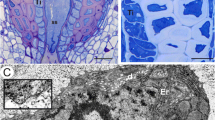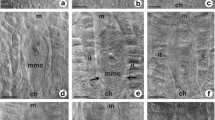Summary
Prior to postgenital fusion the epidermal cells on the distal, adaxial faces of the carpels ofCatharanthus roseus are meristematically active but display little evidence of cell wall material deposition. The outer, tangential wall appears homogeneous except for two very thin bands at the outermost boundary. The innermost band (9–10 nm wide) is darkly staining and corresponds in position to the so-called pectin layer. In light of experiments using SEM to demonstrate a thin layer of lipid material on the cell surface, the less darkly staining, outer band (12.5 nm wide) is interpreted as the cuticle proper. The fibrillar wall material extending into the plant cuticle persisted after cuticle extraction, while a smooth, nonfibrillar surface remained after the cuticle was stabilized with osmium tetroxide. The cuticle on the fusion surfaces inC. roseus is concluded to consist only of cutin.
Similar content being viewed by others
References
Baker, E. A., R. F. Batt, M. F. Roberts, andJ. T. Martin, 1962: Studies on plant cuticle: Progress report. Ann. Rep. Long Ashton Res. Sta. 1961, p. 114.
— andJ. T. Martin, 1963: Cutin of plant cuticles. Nature199, 1268.
—,R. F. Batt, andJ. T. Martin, 1964: Studies on plant cuticle. VII. The nature and determination of cutin. Ann. appl. Biol.53, 59–65.
Baum, H., 1948 a: Postgenitale Verwachsung in und zwischen Karpell- und Staubblattkreisen. Sitz.-Ber. Akad. Wiss. Wien, math.-nat. Kl., Abt. 1.157, 17–38.
—, 1948 b: Über die postgenitale Verwachsung in Karpellen. Österr. bot. Z.95, 86–94.
—, 1948 c: Die Verbreitung der postgenitalen Verwachsung im Gynözeum und ihre Bedeutung für die typologische Betrachtung des coenokarpen Gynözeums. Österr. bot. Z.95, 124–128.
—, 1949: Zur Frage des schrittweisen Überganges vom apokarpen zum coenokarpen Gynö-zeum. Österr. bot. Z.95, 470–474.
Boeke, J. H., 1971: Location of the postgenital fusion in the gynoecium ofCapsella bursapastoris (L.). Med. Acta bot. Neerl.20, 570–576.
—, 1973 a: The postgenital fusion in the gynoecium ofTrifolium repens L.: light and electron microscopical aspects. Acta bot. Neerl.22, 503–509.
—, 1973 b: The use of light microscopy versus electron microscopy for the location of postgenital fusions in plants. Proc. K. Ned. Akad. Wet., Ser. C., Biol. Med. Sci.76, 528–535.
Bystrom, B. G., R. B. Glater, F. M. Scott, andE. S. C. Bowler, 1968: Leaf surface ofBeta vulgaris: Electron microscope study. Bot. Gaz.129, 133–138.
Chafe, S. C., andA. B. Wardrop, 1972: Fine structural observations on the epidermis. I. The epidermal cell wall. Planta107, 269–278.
Cusick, F., 1966: On phylogenetic and ontogenetic fusions. In: Trends in plant morphogenesis (E. G. Cutter, ed.), pp. 170–183. London: Longmans, Green, and Co.
Frey-Wyssling, A., andK. Mühlethaler, 1965: Ultrastructural plant cytology. Amsterdam-London-New York: Elsevier Publ. Co.
Holloway, P. J., andE. A. Baker, 1968: Isolation of plant cuticles with zinc chloridehydrochloric acid solution. Plant Physiol.43, 1878–1879.
Huelin, F. E., 1959: Studies in the natural coating of apples. IV. The nature of cutin. Aust. J. biol. Sci.12, 175–180.
Kolattukudy, P. E., 1970: Biosynthesis of cuticular lipids. Ann. Rev. Plant Physiol.21, 163–192.
Lamond, M., etJ. Vieth, 1972: L'androcée synanthéré duRechsteineria cardinalis (Gesnériacées). Une contribution au problème des fusions. Canad. J. Bot.50, 1633–1637.
Martin, J. T., andB. E. Juniper, 1970: The cuticles of plants. London: Edward Arnold (PubL).
Mazliak, P., 1968: Chemistry of plant cuticles. In: Progress in phytochemistry 1 (L. Rein-hold andY. Lienschitz, eds.), pp. 49–111. Interscience Publ., N.Y.
Mueller, L. E., P. H. Carr, andW. E. Loomis, 1954: The submicroscopic structure of plant surfaces. Amer. J. Bot.41, 593–600.
Newcomb, E. H., 1963: Cytoplasm—cell wall relationships. Ann. Rev. Plant Physiol.14, 43–64.
Norris, R. F., andM. J. Bukovac, 1968: Structure of the pear leaf cuticle with special reference to cuticular penetration. Amer. J. Bot.55, 975–983.
O'Brien, T. P., 1967: Observations on the fine structure of the oat coleoptile. I. The epidermal cells of the extreme apex. Protoplasma63, 385–416.
Orgell, W. H., 1955: The isolation of plant cuticle with pectic enzymes. Plant Physiol.30, 78–80.
Roelofsen, P. S., 1952: On the submicroscopic structure of cuticular cell walls. Acta bot. Neerl.1, 99–114.
Schieferstein, R. H., andW. E. Loomis, 1956: Wax deposits on leaf surfaces. Plant Physiol.31, 240–247.
— —, 1959: Development of the cuticular layers in angiosperm leaves. Amer. J. Bot.46, 625–635.
Schönherr, J., andM. J. Bukovac, 1973: Ion exchange properties of isolated tomato fruit cuticular membrane: Exchange capacity, nature of fixed charges and cation selectivity. Planta109, 73–93.
Scott, F. M., K. C. Hammer, E. Baker, andE. Bowler, 1958: Electron microscope studies of the epidermis ofAllium cepa. Amer. J. Bot.45, 449–461.
Vieth, J., etM. Lamond, 1973: Contribution á la térotologie des chèvrefeuilles et au problème des fusions. Canad. J. Bot.51, 517–525.
Walker, D. B., 1975 a: Flower. In: 1975 McGraw-Hill yearbook of science and technology, pp. 195–197. New York: McGraw-Hill.
—, 1975 b: Postgenital carpel fusion inCatharanthus roseus. I. Light and scanning electron microscopic study of gynoecial ontogeny. Amer. J. Bot.62, 457–467.
—, 1975 c: Postgenital carpel fusion inCatharanthus roseus. III. Fine structure of the epidermis during and after fusion. Protoplasma86, 43–63.
Wilson, L. A., D. V. Beavers, andR. F. Cain, 1972: Structure of the Royal Ann cherry cuticle and its significance to cuticular penetration. Amer. J. Bot.59, 722–728.
Author information
Authors and Affiliations
Rights and permissions
About this article
Cite this article
Walker, D.B. Postgenital carpel fusion inCatharanthus roseus . Protoplasma 86, 29–41 (1975). https://doi.org/10.1007/BF01275621
Received:
Revised:
Issue Date:
DOI: https://doi.org/10.1007/BF01275621




